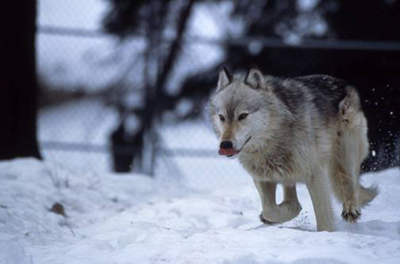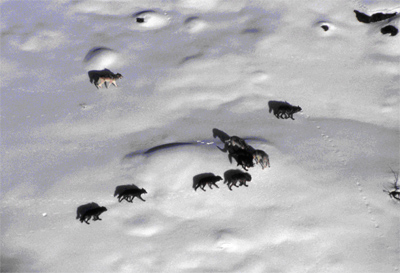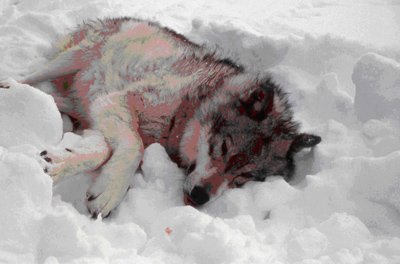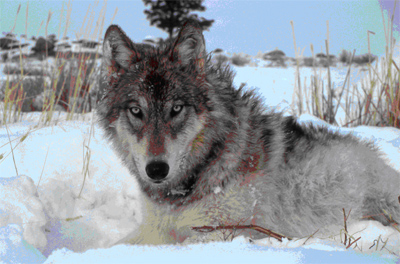
Reintroduction of wolves brings controversy
These days, wolves mean controversy in the west.
Wildlife Service agents killed two wolves last month that had attacked livestock in Sun Valley, Idaho.
This year, wolves have killed 21 cows, 170 sheep and four dogs. And in return, a total of 35 wolves have been killed by federal agents, seven have been shot by ranchers and six have been illegally slaughtered.
The extensive history of wolves attacking livestock has created a hateful relationship between beast and rancher.
 |
A Yellowstone National Park wolf races across snow during winter (Photo courtesy of Barry O’Neill and the National Park Service). |
These predators prefer to prey on slower and weaker animals, thus making livestock animals, such as cows and goats, perfect candidates for a wolf’s diet.
As a result, ranchers, for centuries, have considered the wolf an arch enemy and have done everything in their power to protect their precious and valuable livestock.
Since there were no hunting restrictions for wolves in the past, their packs were almost extinguished and various species of wolves have been placed on the “Endangered Species” list, forcing many to be reintroduced to their native habitats.
Reintroduction of native species to our national parks has been positive for many species but has also stirred much debate, especially the reintroduction of the gray wolves to Yellowstone National Park, in Wyoming, Montana, and Idaho.
“National parks are ideal places for restoration of federally and state listed species because of the National Park Service mission of preserving and protecting the natural resources of the parks unimpaired by human activities for present and future generations,” said Jeff Olson, public affairs officer for the National Park Service.
Wolves once flourished throughout the western United States, especially in the Rockies, but were slowly eliminated by humans. They were considered endangered and in 1987, under the provision of the Endangered Species Act, a Rocky Mountain Wolf Recovery plan was approved by the National Fish and Wildlife Service and reintroduction began in the states of Montana, Idaho and Wyoming.
“The gray wolf reintroduction has been a huge success. The wolves are reproducing, have had accelerated mating and pack formation, and have been fully recovered in Wyoming, Montana, and Idaho,” said Sharon Rose, spokesperson for the U.S. Fish and Wildlife Service.
Now, with such a viable gray wolf population, problems have arisen with wolves that leave the parks and kill surrounding area livestock.
“Wolves sexually mature at two years of age, so they will leave the park in search of their own territory. In doing so, they will kill livestock for food,” said Deb Guernsey, a biological science technician for the Wolf Project at Yellowstone National Park.
Although Yellowstone National Park was one of the two release areas for wolves, since they were also released in nonfederal land in Idaho, the gray wolves at Yellowstone are often blamed for harassing and attacking livestock.
Due to the livestock losses, the American Farm Bureau Federation sued the reintroduction program in 1994. It stated that the program violated the Endangered Species Act since the program made it illegal for ranchers to hunt the wolves, even though, under the act, reintroduced wolves were seen as an “experimental population” and should not be protected.
The Federation demanded that the wolves be removed from Yellowstone and, in 1997, a judge upheld the appeal. However, that order was appealed and recently, another court ordered that the wolves should remain in the park.
| A pack of Yellowstone National Park wolves (Photo courtesy of the National Park Service). |  |
Because of the vague wolf protection laws, ranchers continue to have problems with livestock losses due to lone wolves.
“If there was adequate protection for ranchers against wolves then the wolf reintroduction program would have been more palatable for ranchers, but there isn’t, so it’s difficult to support,” said Rick Krause, senior director of Regulations for the American Farm Bureau Federation.
The animal rights organization Defenders of Wildlife, based in Washington, D.C., has attempted to appease the ranchers by having a compensation program for the livestock lost due to endangered species.
“Since the program began in 1987, the organization has given $800,000 to ranchers for herding dogs, mules, and other livestock that have been killed by endangered animals, such as wolves or bears,” said Suzanne Stone, Northern Rockies representative for Defenders of Wildlife.
The ranchers have also been taught scare tactics in order to frighten the wolves away.
Despite compensatory efforts by Defenders of Wildlife, the American Farm Bureau Federation remains troubled by the outcome.
“The Defenders of Wildlife organization has been helpful in some cases, but for others it hasn’t been. They did help incur losses, but the money doesn’t seem to have been available uniformly and it wasn’t full compensation for the losses,” Krause said.
Other wolf reintroduction programs haven’t been as successful or stirred as much debate as the gray wolves in Yellowstone.
At the Great Smoky Mountain National Park located in western North Carolina and east Tennessee, the U.S. Fish and Wildlife Service attempted reintroduction of red wolves.
Red wolves disappeared from the park area in the early 1900s for unknown reasons and the wolf project was very well accepted by the surrounding population, but it seems that the new environment was not suitable for them.
 |
This Yellowstone wolf was tranquilized to be collared for tracking and then was released (Photo courtesy of Bill Campbell and the National Park Service). |
“The red wolves were released in the early 1990s and, by 1998, they had very low breeding and pup survival. Because the park has very few meadows, an environment in which the wolves thrive, a food supply shortage could’ve been the reason for the program’s failure,” said Bob Miller, spokesman for the Great Smoky Mountain National Park.
The debate over the reintroduction of wolves continues today. As the population has grown, packs of wolves have left the protected areas of the parks and have claimed their own territories in surrounding areas.
Since the park is now saturated with gray wolves, wolves are currently in the process of being de-listed as endangered in the Rocky Mountains, making them lose their protection, thus becoming vulnerable to getting shot by ranchers.
“The wolves in the northern Rockies will soon be de-listed and subjected to different management actions and policies by the respective states. It will then be important that the national parks in that region remain as core sanctuaries for source populations,” said Olson.
Besides the problems with ranchers, the wolf recovery has been very positive for the ecosystem at Yellowstone.
“Biologically, wolves are a keystone species; they literally are the ‘top dogs’ and they help keep the natural balance between predators and prey,” said Guernsey.
The wolf program has also launched a new source of revenue to the park because many of the
tourists come just to catch a glimpse of these creatures, therefore creating a demand for wolf-watching guides and wolf-related products.“People enjoy seeing wildlife in the parks and often site this as an example for visiting parks. The increased visitation also results in economic benefits to surrounding communities,” said Olson.
Reintroduction of wolves has ceased in Yellowstone and their main focus now is to maintain their habit so that the gray wolves aren’t returned to the endangered list again.
| A Yellowstone wolf poses (Photo courtesy of Doug Smith and the National Park Service). |  |
“Reintroduction is an option for recovery, but not preferred. We’d rather do all that is possible to step in before an animal is endangered by improving the habitat and the management of the species,” said Rose.
The reintroduction of native species continues nationwide, with species such as peregrine falcons
being reintroduced to the Great Smoky Mountains National Park, blue butterflies in Biscayne National Park in South Florida, cutthroat trout in the Great Basin National Park in Nevada, and black-footed ferrets will be brought back to Wind Cave National Park in South Dakota.
To learn more about the gray wolf issue, visit Defenders of Wildlife Web site at: http://www.defenders.org/wildlife/new/wolves.html.

Comments are Closed